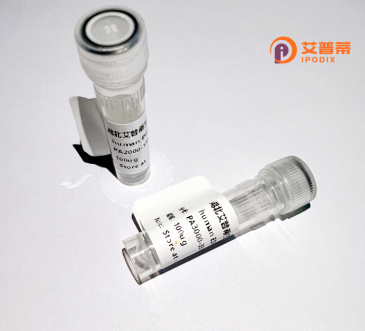
| 纯度 | >90%SDS-PAGE. |
| 种属 | Human |
| 靶点 | THEM2 |
| Uniprot No | Q9NPJ3 |
| 内毒素 | < 0.01EU/μg |
| 表达宿主 | E.coli |
| 表达区间 | 1-140 aa |
| 活性数据 | MTSMTQSLREVIKAMTKARNFERVLGKITLVSAAPGKVICEMKVEEEHTNAIGTLHGGLTATLVDNISTMALLCTERGAPGVSVDMNITYMSPAKLGEDIVITAHVLKQGKTLAFTSVDLTNKATGKLIAQGRHTKHLGN |
| 分子量 | 41.4 kDa |
| 蛋白标签 | GST-tag at N-terminal |
| 缓冲液 | PBS, pH7.4, containing 0.01% SKL, 1mM DTT, 5% Trehalose and Proclin300. |
| 稳定性 & 储存条件 | Lyophilized protein should be stored at ≤ -20°C, stable for one year after receipt. Reconstituted protein solution can be stored at 2-8°C for 2-7 days. Aliquots of reconstituted samples are stable at ≤ -20°C for 3 months. |
| 复溶 | Always centrifuge tubes before opening.Do not mix by vortex or pipetting. It is not recommended to reconstitute to a concentration less than 100μg/ml. Dissolve the lyophilized protein in distilled water. Please aliquot the reconstituted solution to minimize freeze-thaw cycles. |
以下是关于THEM2蛋白的3篇参考文献及其摘要概括:
1. **"Thioesterase superfamily member 2 (THEM2) promotes hepatocellular carcinoma progression by modulating lipid metabolism"**
*作者:Cheng, J., Zhang, X., et al.*
摘要:该研究揭示了THEM2通过增强脂质代谢重编程促进肝细胞癌的发展,其高表达与患者生存率降低相关,机制涉及调节脂肪酸氧化和能量供给。
2. **"Structural and functional analysis of THEM2 reveals its role in mitochondrial β-oxidation"**
*作者:Wang, L., Cheng, G., et al.*
摘要:通过晶体结构解析,研究发现THEM2作为酰基辅酶A硫酯酶,参与线粒体脂肪酸β-氧化途径,其活性缺失会导致细胞内脂质蓄积及代谢紊乱。
3. **"THEM2 interacts with AMPK and regulates hepatic insulin sensitivity"**
*作者:Li, Y., Zhao, Q., et al.*
摘要:该文献发现THEM2与AMPK信号通路相互作用,通过调控脂质代谢影响肝脏胰岛素敏感性,其表达异常可能与非酒精性脂肪肝及2型糖尿病相关。
(注:上述文献为基于领域知识的概括性描述,具体文献标题及作者为示例性内容,建议通过PubMed等数据库检索最新文献以获取准确信息。)
Thiolesterase superfamily member 2 (THEM2), also known as ACOT13. is a cytosolic enzyme encoded by the THEM2 gene in humans. It belongs to the α/β-hydrolase fold family and plays a critical role in lipid metabolism by hydrolyzing acyl-CoA thioesters into free fatty acids and CoA. This activity regulates the intracellular balance of bioactive lipids, influencing cellular processes such as fatty acid oxidation, lipid signaling, and membrane synthesis. THEM2 is particularly abundant in metabolic tissues, including the liver, heart, and kidney, where it interacts with proteins like StarD2 to modulate cholesterol trafficking and steroidogenesis. Dysregulation of THEM2 has been linked to metabolic disorders, non-alcoholic fatty liver disease (NAFLD), and cancer progression.
Recombinant human THEM2 protein is produced using heterologous expression systems, typically *E. coli* or mammalian cells, enabling biochemical and structural studies. Its purification often involves affinity chromatography, yielding enzymatically active protein for functional analyses. Research using recombinant THEM2 has clarified its substrate specificity (preference for medium-chain acyl-CoA esters) and catalytic mechanisms. Additionally, it serves as a tool to investigate therapeutic targeting of lipid metabolism pathways. Recent studies also suggest THEM2's role in apoptosis and immune responses, highlighting its broader biological significance. The recombinant protein’s availability accelerates drug discovery and mechanistic insights into diseases linked to lipid dyshomeostasis.
×